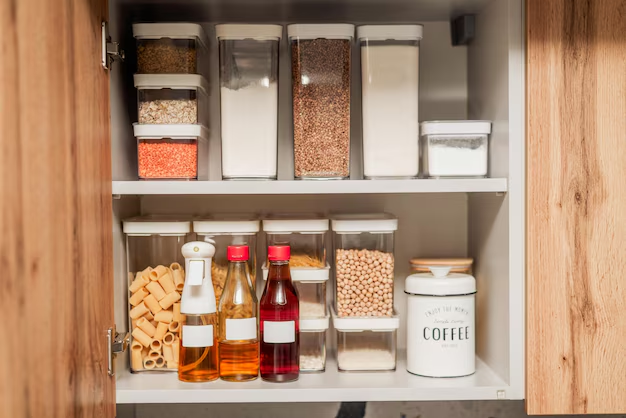The Ultimate Guide to Efficiently Stocking Your Refrigerator
Keeping your refrigerator well-organized not only prolongs the life of your groceries but also can significantly cut down on waste and meal prep time. Whether you’re a busy parent, a culinary enthusiast, or someone aiming to reduce waste, knowing how to stock your refrigerator effectively is essential. This guide delves into the nuances of refrigerator organization and provides you with compelling tips to enhance your kitchen efficiency.
🥕 Why Refrigerator Organization Matters
A well-organized refrigerator can be a game changer in your daily routine. Here’s why you should care:
- Reduces food waste: By clearly seeing what you have, you're less likely to overlook perishables that might expire.
- Saves money: Making the most of your produce and groceries means you buy less.
- Enhances food safety: Proper organization ensures different types of food are stored at their optimal temperatures to minimize the risk of spoilage and contamination.
- Streamlines meal prep: Finding ingredients quickly helps keep your meal preparation efficient.
🧊 The Science of Refrigerator Layout
Understanding the different zones within your fridge will elevate your organization game. Here’s how to stock based on temperature variations:
H2: Upper Shelves
These shelves are usually consistent in temperature:
- Best for drinks: Place beverages like juices and milk alternatives here where the cool air stays even.
- Leftovers: Keeping leftovers at eye level ensures they're consumed before they spoil.
- Ready-to-eat foods: Yogurt, hummus, and other snacks are perfect for this level.
H2: Middle and Lower Shelves
These areas are slightly colder:
- Dairy products: Keep milk, cheese, and similar items fresher here.
- Eggs: The colder part of the main compartment is ideal even though common practice often places them in the door.
- Raw meat: If not stored in a separate drawer, place meats on a plate or tray to prevent contamination.
H2: Drawers
Use these specifically designed compartments for:
- Crisper drawers: These have humidity control settings for fruits (low humidity) and vegetables (high humidity).
- Deli drawer: If available, it's great for lunch meats and cheeses.
H2: Door
The warmest part of your refrigerator is perfect for:
- Condiments: Shelf-stable sauces and pickles suit this space.
- Butter and soft cheese: These need less-cold conditions to remain spreadable.
🗂️ Tips for Optimizing Space
Maximizing the available space in your refrigerator is key to keeping your kitchen organized:
- Use clear bins: Categorize similar items in clear plastic bins, allowing for easy access and visibility.
- Adjust shelves: Many refrigerators have adjustable shelving—utilize this feature to create space for taller items or additional bins.
- Stack items carefully: Keep heavier items on the bottom to prevent crushing more delicate goods.
- Label drawers and sections: Labeling promotes consistency among all household members, keeping your fridge orderly.
🍎 Food Storage Techniques and Their Benefits
Learn how to extend the life of your fresh produce and other groceries through proper storage:
- Root vegetables: Store carrots, beets, and other root vegetables in airy cloth bags to keep them fresh longer.
- Leafy greens: Opt for glass or BPA-free plastic containers lined with paper towels—this absorbs excess moisture.
- Berries and fruits: Store berries in a low humidity drawer, while citrus fruits are happy in the high-humidity tray.
- Herbs: Treat herbs like flowers; trim ends and place them in a jar of water in the fridge.
🥚 Maintaining Refrigerator Hygiene
Keeping your refrigerator clean is as crucial as organizing it. A few pointers to ensure it stays spotless:
- Regular cleaning: Aim for a thorough clean once a month using a solution of baking soda and water.
- Absorb odors: Place an open box of baking soda on one of the shelves and replace it every few months.
- Wipe spills immediately: Prevent odors and sticky residue by cleaning up spills when they occur.
- Wheel rotation: Turn your stored items regularly to use older produce first and avoid them lurking past their prime.
📋 Quick Organization Checklist
Here's a handy checklist to keep your refrigerator optimally stocked and organized:
- 📅 Check for expired items weekly and dispose of them.
- 🥛 Rotate items to the front that need to be used soon.
- 🧊 Ensure proper temperature settings are maintained: 37°F (3°C) for the main compartment and 0°F (-18°C) for the freezer.
- 🍎 Utilize storage accessories like fridge bins, tiered shelves, and lazy Susans to maximize space.
- 🔄 Cultivate a system for newcomers to put groceries away and maintain the organization.
🔄 Process of Restocking
Stocking the refrigerator efficiently isn't just about filling it. It involves methodical planning and thoughtful placement:
- Plan meals weekly to help streamline grocery purchases.
- Identify essential items: Make a list of staples you always need.
- Group similar foods together: This speeds up finding what you need.
- Avoid overfilling: Ensure air can circulate around the items.
🌟 Wrap-Up: The Benefits of an Organized Refrigerator
Implementing these strategies can transform not only how you stock your fridge but also how you plan your meals and ultimately, how you live. An organized fridge leads to less waste, more savings, and smoother meal prep. Take control and start reaping the benefits of a well-stocked and efficiently organized refrigerator today. You’d be amazed at how these subtle changes can lead to a profound impact on your everyday life.
By weaving in these practical strategies and insights, not only will your refrigerator organization improve, but you will also see noticeable differences in the way you cook, eat, and shop for groceries. Here's to happier, more efficient meal planning and kitchen management! 🥳
